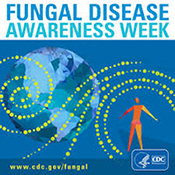 NOTE: To encourage more young artists to participate, the deadline for entries for this contest was moved by the Arizona Department of Health Services from Nov. 14 to Friday, Dec. 14. Same prizes, same rules, same links to information below!
NOTE: To encourage more young artists to participate, the deadline for entries for this contest was moved by the Arizona Department of Health Services from Nov. 14 to Friday, Dec. 14. Same prizes, same rules, same links to information below!
 The 2018 Valley Fever Awareness Poster Contest has begun!
The 2018 Valley Fever Awareness Poster Contest has begun!
The Arizona Department of Health Services (ADHS) is partnering with the University of Arizona Valley Fever Center for Excellence (VFCE) and Pueblo Magnet High School to run an awareness poster contest regarding this fungal disease. The statewide contest starts now and will end in the middle of Valley Fever Awareness Week, which is Nov. 10–18. Winners will be announced and prizes sent out soon after the competition ends on Friday, Dec. 14.
 The contest was announced on Oct. 1, the start of national Fungal Disease Awareness Week, Oct. 1-5, 2018. Learn more about fungal diseases like Valley fever at the U.S. Centers for Disease Control & Prevention website: https://www.cdc.gov/fungal/awareness-week.html
The contest was announced on Oct. 1, the start of national Fungal Disease Awareness Week, Oct. 1-5, 2018. Learn more about fungal diseases like Valley fever at the U.S. Centers for Disease Control & Prevention website: https://www.cdc.gov/fungal/awareness-week.html
All Arizona residents 18 years and younger are eligible to participate by creating a poster that uses some (or all) of the following messages to increase the public’s knowledge about Valley Fever.
These include:
- Know the signs and symptoms of Valley Fever
- Ask your doctor to test you if you think you have Valley Fever
- Stay out of blowing dust
- Wet the ground before disturbing the soil
- ANYONE can get Valley Fever – even healthy people, DOGS, and other pets
Rules & Entry Form
Mail poster and Entry Form to: Guillermo Adame, Arizona Department of Health Services 150 N. 18th Ave., Suite 140, Phoenix, AZ 85007
Or, email the entry form and scanned poster to cocci@azdhs.gov
For additional questions about the contest, please check out the "FAQs" tab at the Valley Fever Awareness Poster Contest webpage (also available below in “EXTRA INFO”) or contact the Valley Fever Epidemiologist at cocci@azdhs.gov.
EXTRA INFO: FAQs
What is Valley fever?
Valley Fever (medical name coccidioidomycosis [kok-sid-e-oy-do-my-co-sis] or "cocci" for short) is an infection in the lungs caused by a fungus (scientific name Coccidioides immitis or Coccidioides posadasii) that grows in the soil in Arizona, the southern and central parts of California, and portions of New Mexico, Texas, Nevada, Utah and Washington state. Valley Fever is also found in parts of Mexico, Central and South America. These areas where the fungus grows in the soil are called "endemic."Who can get Valley fever?
Anyone who lives, visits, or travels through the areas where the fungus grows in the soil may acquire Valley Fever. People working in certain occupations such as construction, excavation, agriculture, archaeological digging and other occupations which disturb soil in endemic areas may be at increased risk of exposure. Military personnel training in these areas are also at risk. Persons who pursue recreational activities such as biking or driving ATVs or 4-wheel drive vehicles in the desert may be at increased risk. Various domestic animals such as dogs and horses as well as wild animals are also susceptible.How do people get Valley fever?
Valley Fever is acquired by breathing in airborne spores of the fungus Coccidioides. The spores are carried in dust particles from the soil by the wind when the desert soil is disturbed. Valley Fever is NOT spread from human to human, or animal to animal, or animal to human, or human to animal. The spores change form in the body and are not contagious.What are the symptoms of Valley fever?
Most people with Valley Fever (60%) have no symptoms or only very mild flu-like symptoms and do not see a doctor. The most common symptoms are fatigue, cough, fever, sweating at night, loss of appetite, chest pain, muscle and joint aches, particularly of the ankles and knees. There may also be a rash that resembles hives, but appears more often as tender red bumps on the shins or forearms.People with chronic Valley Fever infections have long lasting symptoms such as low-grade fever, weight loss, cough, chest pain and coughing up blood.
How can you prevent getting Valley fever?
There is no way to prevent Valley Fever at this time. Anyone in the areas where the fungus lives can breathe in infectious spores. Avoiding activities associated with dust and airborne dirt of native desert soil is recommended, but it is not guaranteed to prevent infection. Masks may be worn when engaging in some activities or occupations. Use common sense and stay out of the blowing dust. Learn about the disease and tell your friends and family. If you are experiencing symptoms of Valley Fever, ask your doctor to test you for it.How much does it cost to enter the Valley Fever Awareness Poster Contest?
Entry is FREE! Just send in your original artwork before Nov. 14, 2018 and you will automatically be entered to win a prize.When will I find out if I won?
Contest ends Friday, Dec. 14, 2018. Winners will be contacted by email or phone and prizes sent out soon after the competition ends.What are the prizes?
Prizes are primarily coupons and admission tickets to various restaurants, activity centers, museums, and other venues around the state. They are awarded by age group and to the first submission received. An overall 1st prize winner will be announced and their poster will be used in future Valley Fever campaigns as well as displayed on the ADHS Valley Fever website.
NOTE TO MEDIA: For educational pamphlets, brochures, images and graphics related to Valley fever—as well as contact information for University of Arizona faculty knowledgeable about the illness—visit the following webpage: UA Expertise on Valley Fever (Coccidioidomycosis)
ALSO SEE:
"New UA/Banner Health Valley Fever Clinical Guidance Designed to Avert Diagnoses Delays" | Posted Oct. 8, 2018
“Patient-Ordered Tests Indicate Valley Fever Uptick in State, UA Infectious Diseases Specialist Says” | Posted June 12, 2018
“Cronkite News Feature on Valley Fever Notes Doctor ‘Lack of Awareness’ Puts Sufferers at Risk” | Posted April 13, 2018

